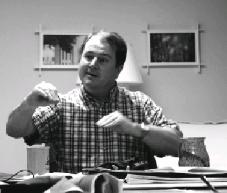|
|
April 12, 2003: Rob Creekmore Smithsonian Associates 2003 |
|
[
Introduction ] [
Jumpstart Storytelling ] [
Values ] [
Putting Story to Work ] [
Future
Stories ] [
Springboard
Stories ]
[ Seth Kahan ] [ Alicia Korten ] [ Rob Creekmore ] [ Madelyn Blair ] [ Steve Denning ] [ Paul Costello ] [ Chronology of Storytelling ] [ Golden Fleece Group ] [ Dave's Story ] [ Preparing the story ] |
|
Rob Creekmore Transcript of the April 12, 2003 session at the Smithsonian Associates |
| Introduction
by Steve Denning Rob Creekmore's Opening Remarks Joseph Campbell The Fannie Mae Story The Reflection Exercise Paul Costello's Commentary STEVE
DENNING ON ROB CREEKMORE: PUTTING STORIES TO WORK
|
| So we met every other week for three hours. I had them
tell the stories of their experiences at work. “Gosh, I was dealing
with this internal customer, and this happened.” But we didn’t just stop with the stories. We had people share stories and then we would go deeply into some dialogue about the stories. We’d ask questions like: “O.k. so this is what the person said. What do you think they might have been thinking? What kind of assumptions or intentions or agendas lay behind that story?” So we would look at the underlying dynamics. And they started having insights into what was going on behind the story. I worked with them for a whole year. They went from being a |
| (II.15.0.00) Take the moment that you’ve identified for yourself and
identify a character in the story. What character resonates with you
the most? (The participants reflect) What is the character feeling? (The participants reflect) What are the assumptions, the agendas of the character? (The participants reflect) Finally what are the values of the character? (The participants reflect) Then share with your table your reflections on the story. (The participants share their reflections.) |
| Now consider some key questions. What does this tell you
about the story? Is there some kind of deeper meaning to the story that’s
starting to come forward? What patterns might be emerging here? What
different interpretations emerged? Does this reveal something about
you as a group? (The participants share their reflections.) This is just one technique aimed at getting inside a story. There are others. It’s one way of working with a story that’s already told and understanding that more deeply. What’s it for? · It may reveal hidden thinking not visible even to the storyteller. · It can also be used to reveal lessons learned. They may be useful or they may be dysfunctional. · It’s a way of uncovering the tacit understanding and values. Then you can do something with them, like the future stories that Madelyn will introduce us to after lunch. · It can build bridges of understanding in a group, say, in a team building session. We start to understand metaphors and patterns in the stories. · It may reveal hidden talents and skills. So that’s the presentation. (applause) |
| That draws from a religious tradition. If you want to
know how to interpret stories that go to deeper levels, then you go
to Midrash , and Kabbala. You go to Lexio Divina, that the Benedictine
monks have evolved over thousands of years. So there’s a deep religious
tradition and a theological tradition. The pioneers of narrative thinking,
if you want to think about the modern era, happened in the 1970s. It’s
in narrative theology. It’s names like John Shea . There’s an untapped
goldmine of knowledge on narrative and it’s in the area of theology,
whether it’s Jewish, or Christian.
Go to the next session on April 12, 2003: Madelyn Blair on Future Stories |
| Blair |
|
|
steve@stevedenning.com www.stevedenning.com |
| Costello |
paulstorywise@yahoo.com www.storywise.com |
|
|
| |
|
Korten |
Tel.
202 364-5369; |
|
|
The
Springboard: How Storytelling Ignites Action in Knowledge-Era Organizations
by Steve Denning (October 2000) Butterworth-Heinemann, Boston, USA Paperback - 192 pages. ISBN: 0750673559 |
|
advance chapters of : |
The
Squirrel: The Seven Highest Value Forms of Organizational Storytelling
by Steve Denning (work in progress) |

